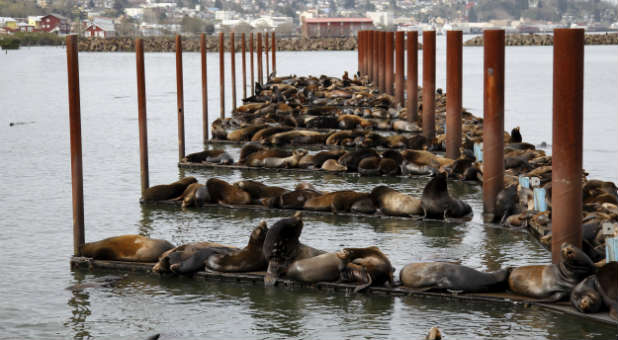A record 2,250 sea lions, mostly pups, have washed up starving and stranded on Southern California beaches so far this year, a worsening phenomenon blamed on warming seas in the region that have disrupted the marine mammals’ food supply.
The latest tally, reported on Monday by the National Marine Fisheries Service, is 20 times the level of strandings averaged for the same three-month period over the past decade and twice the number documented in 2013, the previous worst winter season recorded for Southern California sea lions.
Scientists believe the animals are suffering from a scarcity of natural prey that has forced nursing mothers to venture farther out to sea for food, leaving their young behind to fend for themselves for longer periods of time.
The shift in the food chain around the marine mammals’ principal rookeries off Southern California is believed to be triggered by warming waters linked to unusually weak winds along the West Coast.
Stronger winds normally help pull nutrient-rich cooler water from the depths of the Pacific closer to the surface, and with it larger supplies of sardines, smelt, squid and other prey for the sea lions, said Michael Milstein, a spokesman for the Marine Fisheries Service.
Experts theorize this winter’s mild El Nino effect, which alters ocean currents and temperatures, may be compounding the food shortage for Southern California sea lions.
The same factors appear to driving adult male sea lions by the thousands into the Pacific Northwest, where they have been congregating on docks and jetties to gorge on an unusual abundance of prey in places like the mouth of the Columbia River, Milstein said.
Meanwhile, the surge in Southern California strandings has inundated marine mammal rescue centers from Santa Barbara to San Diego. Rescue teams work to save, rehabilitate and ultimately return the animals to the wild.
The weaker winds and rising ocean temperatures off Southern California have been occurring since 2013, when an earlier surge in strandings prompted the agency to declare an “unusual mortality event.”
Milstein said scientists studying the phenomenon consider the elevated stranding numbers during the past three years to be one continuous trend, even though the tally so far this year far exceeds anything previously documented.
The 2,250 strandings encompass only sea lions found alive and brought into rescue centers; they do not include an as-yet unknown number of animals that have died, Milstein said.
But with a total California sea lion population estimated to be 300,000 animals, of which roughly 60,000 are juveniles, “the overall mortality this year could be significant.”
The fisheries service, an agency of the National Oceanic and Atmospheric Administration, began closely tracking sea lion strandings off California in 2004, he said. The tally of stranding for March, 1,050, represents the largest number recorded for a single month since then.
© Thomson Reuters 2015. All rights reserved.
See an error in this article?
To contact us or to submit an article





















